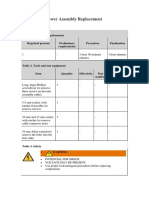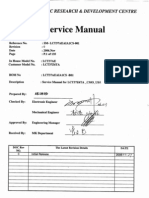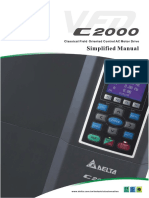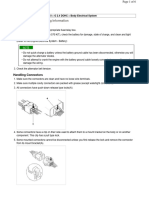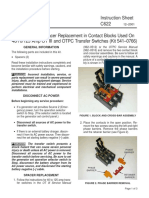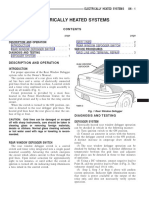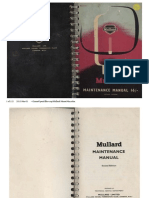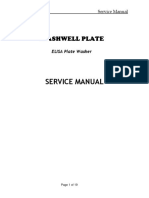Coil Signal Status - Deh41517
Coil Signal Status - Deh41517
Uploaded by
Colby BaxterCopyright:
Available Formats
Coil Signal Status - Deh41517
Coil Signal Status - Deh41517
Uploaded by
Colby BaxterOriginal Title
Copyright
Available Formats
Share this document
Did you find this document useful?
Is this content inappropriate?
Copyright:
Available Formats
Coil Signal Status - Deh41517
Coil Signal Status - Deh41517
Uploaded by
Colby BaxterCopyright:
Available Formats
1
Introduction
Coil Signaling Contacts:
Coil Signaling Contacts indicate the status of the
coil they are installed on. Coil Signaling Contacts
consists of two switches thus enables the status
of the coils thru trip unit and the secondary
disconnect. Status switch thru secondary
disconnect can be power rated or signal rated.
Status switch thru trip unit is a signal rated.
Table 1. Catalog Number and Ratings:
CSC, Power rated Contact:
Cat no
AC Ratings
125Vdc 6A
GCSP1R
250Vdc 6A
CSC, Signal rated Contact:
Cat no
AC Ratings 125Vac 0.1A
GCSP2R
DC Ratings 30Vdc 0.1A
Use the following procedure to install Release
Indication Contact accessory into the circuit
breaker.
1. Verify that the rating on the Release Indication
Contact identification plate matches the voltage
rating required for the application, as listed in
Table 1.
2. Turn the breaker off and discharge the closing
springs by depressing the OFF and ON buttons in
the sequence OFF-ON-OFF. Verify that the
breaker OFF-ON indicator shows OFF on a green
background and that the charge indicator shows
DISCHARGE on a white background. If installing
in a draw-out type breaker remove breaker from
adaptor (cassette) before continuing.
3. Loosen the 6 screws on front cover (fascia)
using a posidrive screw driver as shown in Fig 1.B
Compact Vacuum Circuit Breaker
Accessories
Coil Signaling Contacts
WARNING: Before installing any accessories, turn the
breaker OFF, disconnect it from all voltage sources,
and discharge the closing spings.
AVERTISSEMENT: Avant dinstaller tout accessoire,
mettre le disjoncteur en position OFF, le dconnecter
de toute tension dalimentation , et dcharger les
resorts darmement
DEH-41517 Installation Instructions
2
Rotate the charging handle down and slide the
front cover over the handle to remove the front
cover as shown in Fig. 1.C.
Figure 1. (A) Front Cover (B) Screw Removal (C) Handle
Rotation
4. Remove the existing coil from the mechanism.
5. Remove the coil cover by pressing the three
snaps as shown in Fig. 2.
Figure 2. Removing the existing cover
6. Align the new cover with Release Indication
Contacts on the coil as shown in Fig. 3.
Figure 3. Cover assembly
7. Guide the wires in the wire opening of the coil
housing as shown in Fig. 4. Press the cover and
ensure the 3 snaps are engaged with the
openings in the coil housing.
Figure 4. Cover assembly
8. Tilt the coil forward and engage the front hooks
into the mechanism top support plate as shown
in the Fig. 5.
Figure 5. Assembly of coil
A
B
C
3
9. Tilt the device backwards until the rear hooks
engage in the slots on the mechanism top
support plate as shown in the Fig. 6.
Figure 6. Assembly of coil
10. Plug the connector from the Release
Indication Contact cover with the connectors
from the harness of the trip unit as shown in Fig.7.
While connecting ensure the coils are connected
with the correct connectors from the harness
such as marked as ST1/UV1/CC/ST2&UV2 from
the respective coils.
11. To reinstall the cover, rotate the charging
handle down and slide the front cover over the
handle to assemble the front cover to housing as
shown in Fig. 8.
Figure 8
12. Ensure the fascia is aligned properly with the
trip unit and the pad lock features of the breaker.
13. Fasten the 4 mounting screws of fascia with
the housing using a pozi drive screwdriver. Apply
torque of 3-4 Nm.
Figure 7. Assembly of connector
4
Reference:
Coil status connection scheme:
These instructions do not purport to cover all details or variations in equipment nor, to provide contingency to be met in connection
with installation, operation, or maintenance. Should further information be desired, or should particular problems arise which are not
covered sufficiently for the purchasers purposes, the matter should be referred to GE.
GE
41 Woodford Ave, Plainville, CT 06062
www.geelectrical.com
2009 General Electric Company
DEH-41420 R2 (05/09)
You might also like
- 200 Series Service Manual FLX200 & SCR200Document39 pages200 Series Service Manual FLX200 & SCR200Carlos Gomez100% (3)
- Leece Neville 4000 Series Alternator Service ManualDocument21 pagesLeece Neville 4000 Series Alternator Service ManualOneil Campbell100% (2)
- 15 Electrical 546CDocument40 pages15 Electrical 546CGabriely MuriloNo ratings yet
- IOT102 SE1867 Progrest - Test1 Nhom8Document5 pagesIOT102 SE1867 Progrest - Test1 Nhom8nkluantran2907No ratings yet
- Maytag 12002039 Motor Conversion InstructionsDocument2 pagesMaytag 12002039 Motor Conversion InstructionsJunkeagleNo ratings yet
- Weldtron, Inc.: Instructions For The Installation of The Weldtron-57 R-57 Idler Control Upgrade KitDocument12 pagesWeldtron, Inc.: Instructions For The Installation of The Weldtron-57 R-57 Idler Control Upgrade KitMark trahanNo ratings yet
- Structural analysisDocument3 pagesStructural analysisAtanda OluwaseunNo ratings yet
- GEH 3416 Shunt Trip DeviceDocument3 pagesGEH 3416 Shunt Trip DevicejadliftboatsetorecordsNo ratings yet
- 62-12685502EKPI - EZGO InstructionsDocument6 pages62-12685502EKPI - EZGO Instructionsgalaxytab2iaNo ratings yet
- 3TW42 DOL StarterDocument26 pages3TW42 DOL StarterluvlijNo ratings yet
- Section 5 - Repair/Replacement Procedures: Part Number/ Nomenclature DescriptionDocument4 pagesSection 5 - Repair/Replacement Procedures: Part Number/ Nomenclature DescriptionGregorio1927No ratings yet
- TROCA DPS CA Se-Synergy-Manager-Ac-Spd-Installation-GuideDocument4 pagesTROCA DPS CA Se-Synergy-Manager-Ac-Spd-Installation-GuideJúliaNo ratings yet
- RDD EngDocument33 pagesRDD EngTony KNo ratings yet
- GE - Shunt TripDocument5 pagesGE - Shunt Triprbabar2000142No ratings yet
- Isuzu+Dmax Colorado+KitDocument2 pagesIsuzu+Dmax Colorado+KitfunaismokNo ratings yet
- Basic System Troubleshooting and RepairDocument20 pagesBasic System Troubleshooting and RepairCric CricNo ratings yet
- Single 100W Solar Panel Off-Grid Installation: 10 Amp PWM Charge ControllerDocument16 pagesSingle 100W Solar Panel Off-Grid Installation: 10 Amp PWM Charge ControllerTed RustNo ratings yet
- Inverter Mid Power Assembly ReplacementDocument13 pagesInverter Mid Power Assembly ReplacementRubén Cadima BarrientosNo ratings yet
- 23 1977 18-Instr PanelDocument4 pages23 1977 18-Instr PanelDaniel DeBelloNo ratings yet
- Model Lp3: Installation and Service Instructions For Streamline™ Lp3 Strobe LightsDocument20 pagesModel Lp3: Installation and Service Instructions For Streamline™ Lp3 Strobe LightsRogers Hermann Olivares CuevaNo ratings yet
- ISS PS Cat 793C2 Manuals 50110 (Model TS793C2)Document27 pagesISS PS Cat 793C2 Manuals 50110 (Model TS793C2)Nicole SmithNo ratings yet
- Charger FLX200Document27 pagesCharger FLX200alvaroeblancorNo ratings yet
- Hyster A935 j16xn Europe Forklift Service Repair Manual 1590765879Document18 pagesHyster A935 j16xn Europe Forklift Service Repair Manual 1590765879Владислав ФофановNo ratings yet
- 62-12685504CKI - Club Car InstructionsDocument6 pages62-12685504CKI - Club Car Instructionsgalaxytab2iaNo ratings yet
- MA Lighting grandMA 1 Service ManualDocument10 pagesMA Lighting grandMA 1 Service ManualDmytro KovalenkoNo ratings yet
- High-Voltage Power-Off and Power-On of Jaguar I-PACE Electric Vehicle (Part 1) - Reference NetworkDocument31 pagesHigh-Voltage Power-Off and Power-On of Jaguar I-PACE Electric Vehicle (Part 1) - Reference Networkgolar3No ratings yet
- Charge Port Chevrolet voltDocument13 pagesCharge Port Chevrolet voltMatthieuBrissetNo ratings yet
- Van'S Aircraft, Inc.: Figure 1: Hooking Up The RelaysDocument1 pageVan'S Aircraft, Inc.: Figure 1: Hooking Up The RelaysMark Evan SalutinNo ratings yet
- FX FXR Service ManualDocument12 pagesFX FXR Service Manualjshutton0414No ratings yet
- Akai LCT37Z6TA CMO (11-27-06) LCDDocument135 pagesAkai LCT37Z6TA CMO (11-27-06) LCDRicardo PicassoNo ratings yet
- Installation Procedure For Ellipsoidal Downlight (A-Lamp) : Caution: (Risk of Fire)Document3 pagesInstallation Procedure For Ellipsoidal Downlight (A-Lamp) : Caution: (Risk of Fire)kelsaildonuNo ratings yet
- Bucky Board Replacement ProcedureDocument19 pagesBucky Board Replacement ProcedurerdzptecNo ratings yet
- Manual - Service - PB560 - English (148-160)Document13 pagesManual - Service - PB560 - English (148-160)STEPHANY VANESSA LOMBANA ROJASNo ratings yet
- Delta VFD c2000 Simplified ManualDocument90 pagesDelta VFD c2000 Simplified Manualjonbird12100% (1)
- CFR SB 072920 4 New DCU cRIO Controller SupersessionDocument7 pagesCFR SB 072920 4 New DCU cRIO Controller SupersessionshazaliNo ratings yet
- Manual AsepticoAEU 707AV2 Rev D 1Document12 pagesManual AsepticoAEU 707AV2 Rev D 1DavidNo ratings yet
- General TroubleshootingDocument6 pagesGeneral Troubleshootingelsheref 2021No ratings yet
- Oim CCM 180abws (A)Document60 pagesOim CCM 180abws (A)jhonolivares2014No ratings yet
- Installation: GuideDocument15 pagesInstallation: GuideJacobus SulastriNo ratings yet
- 2021 Micro Quick Start Guide DigitalDocument12 pages2021 Micro Quick Start Guide Digitalapi-510152620No ratings yet
- Instruction Sheet C622 Instructions For Spacer Replacement in Contact Blocks Used On 40/70/125 Amp OT III and OTPC Transfer Switches (Kit 541-0766)Document3 pagesInstruction Sheet C622 Instructions For Spacer Replacement in Contact Blocks Used On 40/70/125 Amp OT III and OTPC Transfer Switches (Kit 541-0766)Quang Pham100% (1)
- DC Alternator TestDocument5 pagesDC Alternator TestAbdul KhaliqNo ratings yet
- Elna 8300 Sewing Machine Service ManualDocument70 pagesElna 8300 Sewing Machine Service ManualiliiexpugnansNo ratings yet
- Sunglow SG1212 2424Document16 pagesSunglow SG1212 2424ibrargrt100% (1)
- Leveling Arm Replacement: Service InstructionsDocument4 pagesLeveling Arm Replacement: Service InstructionskevinalleinNo ratings yet
- PL Electrically Heated Systems 8N - 1Document4 pagesPL Electrically Heated Systems 8N - 1Pelis CloneNo ratings yet
- Load Cell ManualDocument6 pagesLoad Cell ManualAnand SasidharanNo ratings yet
- Magnetic Sensor TachometerDocument3 pagesMagnetic Sensor Tachometerdominicimlach98No ratings yet
- PV JK03M Connector Installation Manual LHDocument15 pagesPV JK03M Connector Installation Manual LHGigih WijayaNo ratings yet
- VR-Vs V8 Distributor Remove-ReplaceDocument7 pagesVR-Vs V8 Distributor Remove-ReplaceJames MirfinNo ratings yet
- SSC81U Series Electronic Valve Installation Instru - enDocument5 pagesSSC81U Series Electronic Valve Installation Instru - endiego pereiraNo ratings yet
- Junction Block RemoveDocument5 pagesJunction Block RemoveYargen GonzalezNo ratings yet
- Spark Outdoor Enclosure: Installation InstructionsDocument7 pagesSpark Outdoor Enclosure: Installation InstructionsTrongnghia Nick HuynhNo ratings yet
- How To Replace PCD UPS CardDocument3 pagesHow To Replace PCD UPS CardJavier Valencia MurilloNo ratings yet
- Quick Start Ex3200 Ex4200 PDFDocument2 pagesQuick Start Ex3200 Ex4200 PDFindra_uhuiiNo ratings yet
- 4050 TransporterDocument29 pages4050 Transporternat-tamail.ruNo ratings yet
- Manual Ok500 Compress 36 40Document5 pagesManual Ok500 Compress 36 40dinesh35833No ratings yet
- Aspiro - 2RU 3200W Quick Install Guide BCG.00037 PDFDocument2 pagesAspiro - 2RU 3200W Quick Install Guide BCG.00037 PDFlitemenNo ratings yet
- Close Side Setting Sensor SB-96BDocument4 pagesClose Side Setting Sensor SB-96Bjuanandres_martinezNo ratings yet
- The Book of the Singer Junior - Written by an Owner-Driver for Owners and Prospective Owners of the Car - Including the 1931 SupplementFrom EverandThe Book of the Singer Junior - Written by an Owner-Driver for Owners and Prospective Owners of the Car - Including the 1931 SupplementNo ratings yet
- Diesel Engine Care and Repair: A Captain's Quick GuideFrom EverandDiesel Engine Care and Repair: A Captain's Quick GuideRating: 5 out of 5 stars5/5 (1)
- Valve & Amplifier Design, Mullard Maintenance Manual (1961)Document112 pagesValve & Amplifier Design, Mullard Maintenance Manual (1961)Valve Data88% (8)
- Snooker King System Installation and Wiring Manual: Company AddressDocument4 pagesSnooker King System Installation and Wiring Manual: Company AddressChai SilwanusNo ratings yet
- Datasheet PDFDocument15 pagesDatasheet PDFDIONY ARATENo ratings yet
- Item AssortmentDocument270 pagesItem Assortmentconter267No ratings yet
- CB4618 Connection Box Installation ManualDocument16 pagesCB4618 Connection Box Installation Manualjone hurbNo ratings yet
- Summary of Calculation: Pt. Kartini UtamaDocument3 pagesSummary of Calculation: Pt. Kartini UtamaDianWidodoNo ratings yet
- Part List - Placa PotenciaDocument2 pagesPart List - Placa PotenciaJohan Andrade0% (1)
- Electronic: Whole Brain Learning System Outcome-Based EducationDocument19 pagesElectronic: Whole Brain Learning System Outcome-Based EducationTrinidad, Gwen StefaniNo ratings yet
- Using Verilog and System Verilog Design and Verify The Communication Bridge Between APB and I2C ProtocolDocument3 pagesUsing Verilog and System Verilog Design and Verify The Communication Bridge Between APB and I2C ProtocolIJSTENo ratings yet
- Alternating Current Class 12 Notes Chapter 7 - Learn CBSEDocument8 pagesAlternating Current Class 12 Notes Chapter 7 - Learn CBSEgamingiconic650No ratings yet
- t875 Trojan Data SheetsDocument2 pagest875 Trojan Data Sheetsapi-255381998No ratings yet
- Nintendo Entertainment System ArchitectureDocument10 pagesNintendo Entertainment System ArchitectureAlainleGuirec100% (1)
- Material ProjectDocument5 pagesMaterial ProjectRavi VermaNo ratings yet
- Sony Sa-Wm40Document13 pagesSony Sa-Wm40Argelio RodriguezNo ratings yet
- AUTO ELISA PW SERVICE MANUAL WasherDocument19 pagesAUTO ELISA PW SERVICE MANUAL WasherEsneiderNo ratings yet
- Basic Inverting Amplifier CircuitDocument5 pagesBasic Inverting Amplifier CircuitBookMaggotNo ratings yet
- Rich Text Editor FileDocument100 pagesRich Text Editor FilesrgubiliNo ratings yet
- DTS TrafoDocument2 pagesDTS TrafoNicodemus Ervino MandalaNo ratings yet
- Assignments Week09 SolutionDocument3 pagesAssignments Week09 SolutionSamuel AdamuNo ratings yet
- Electrical Engineering Portal Com Electrical Thumb Rules You Must Follow Part 2Document8 pagesElectrical Engineering Portal Com Electrical Thumb Rules You Must Follow Part 2m khNo ratings yet
- WiFi Devices Examples of UseDocument10 pagesWiFi Devices Examples of Useiskandar ghinaNo ratings yet
- Studio - 5000 - MTO ADIOEIU1 V1 0 2202US 1Document50 pagesStudio - 5000 - MTO ADIOEIU1 V1 0 2202US 1Miguel MayoNo ratings yet
- Altitude Corrections For External Insulation Design Iec Standards and Engineering Applications 92 PaperDocument8 pagesAltitude Corrections For External Insulation Design Iec Standards and Engineering Applications 92 PaperDrakhoNo ratings yet
- KJ Liberty Cherokee 2003Document50 pagesKJ Liberty Cherokee 2003Stefano BartaliNo ratings yet
- Impact of Non Linear Load On Power QualityDocument4 pagesImpact of Non Linear Load On Power QualityEditor IJRITCCNo ratings yet
- LANswitchingDocument6 pagesLANswitchinggsicm2No ratings yet
- Rish Xmer Protection CTDocument14 pagesRish Xmer Protection CTAarif PatelNo ratings yet
- 75 300 Specs ReDocument1 page75 300 Specs ReGustavoNo ratings yet
- Vectrix BAT ZAR LFP by GP45EVLFDocument1 pageVectrix BAT ZAR LFP by GP45EVLFR ruizNo ratings yet

















